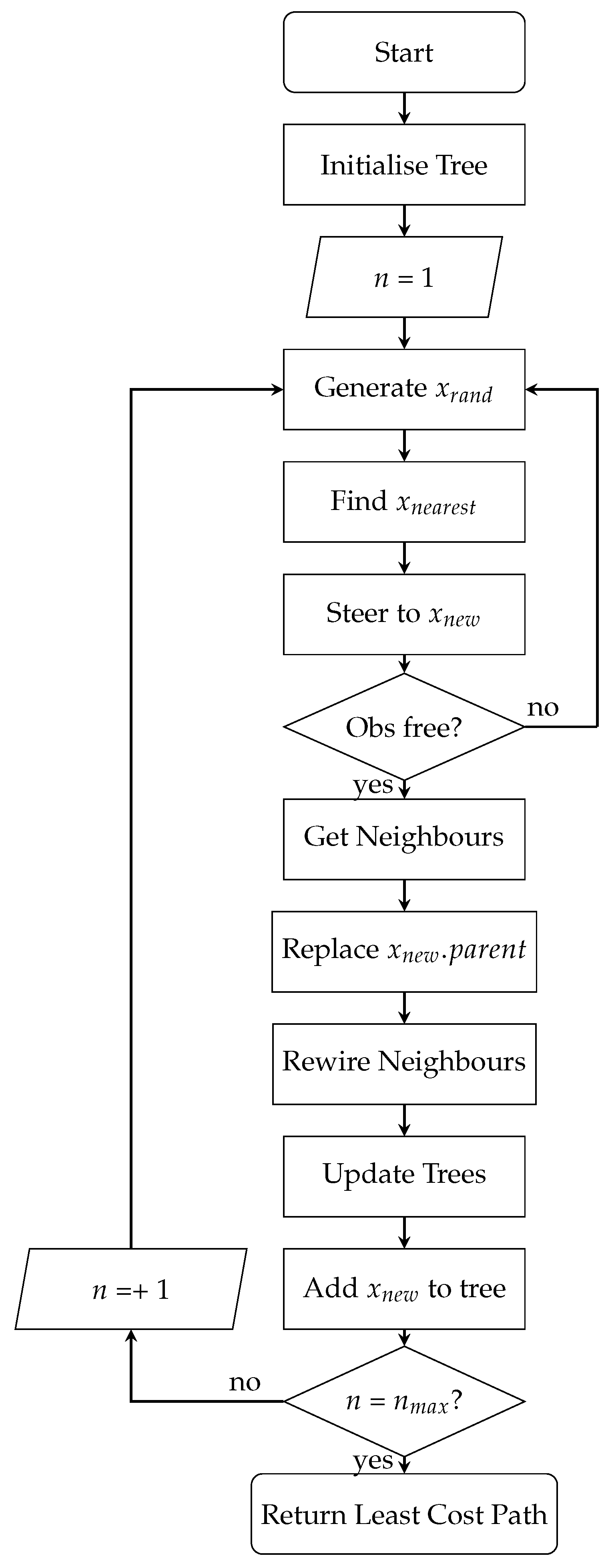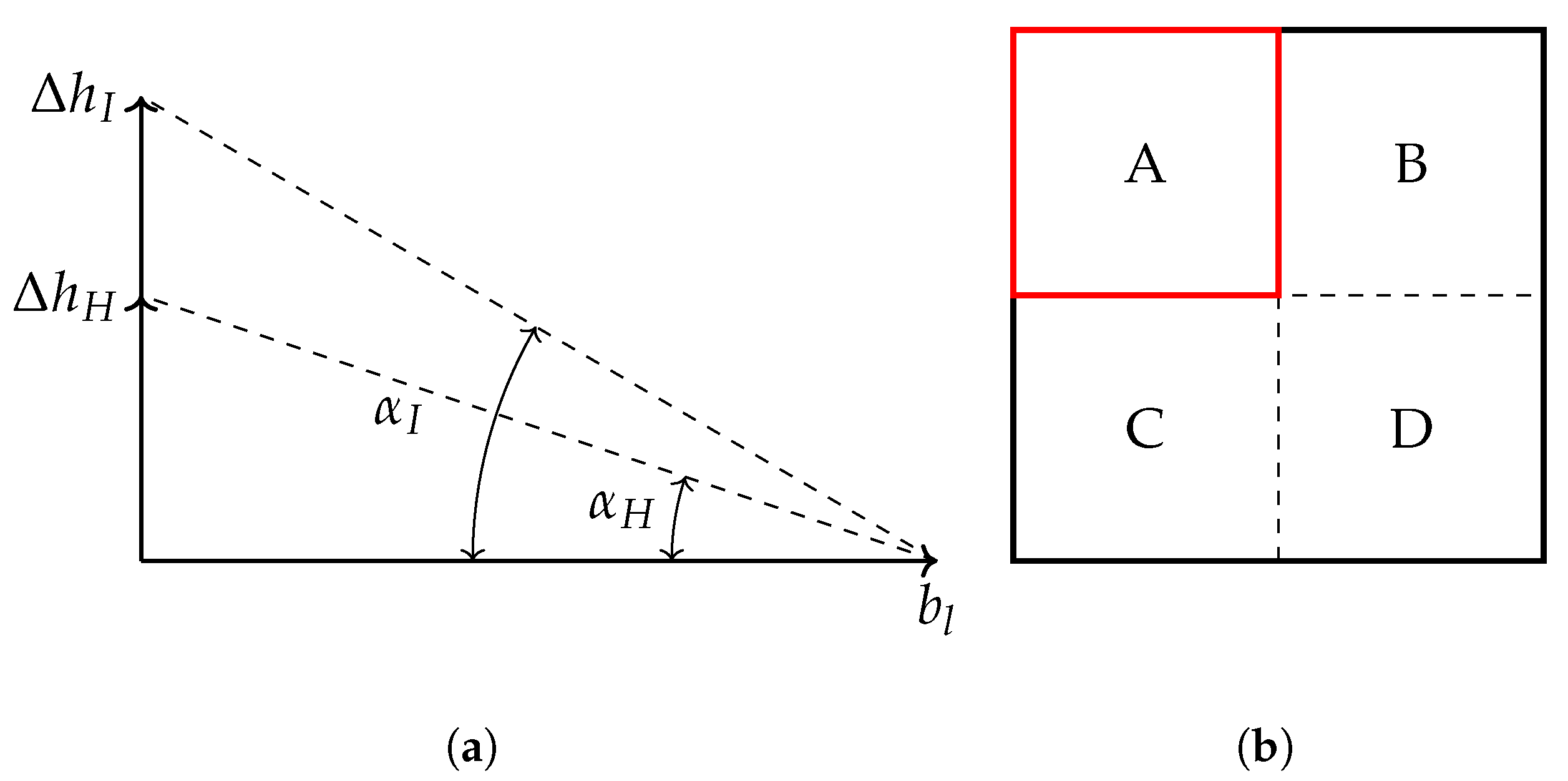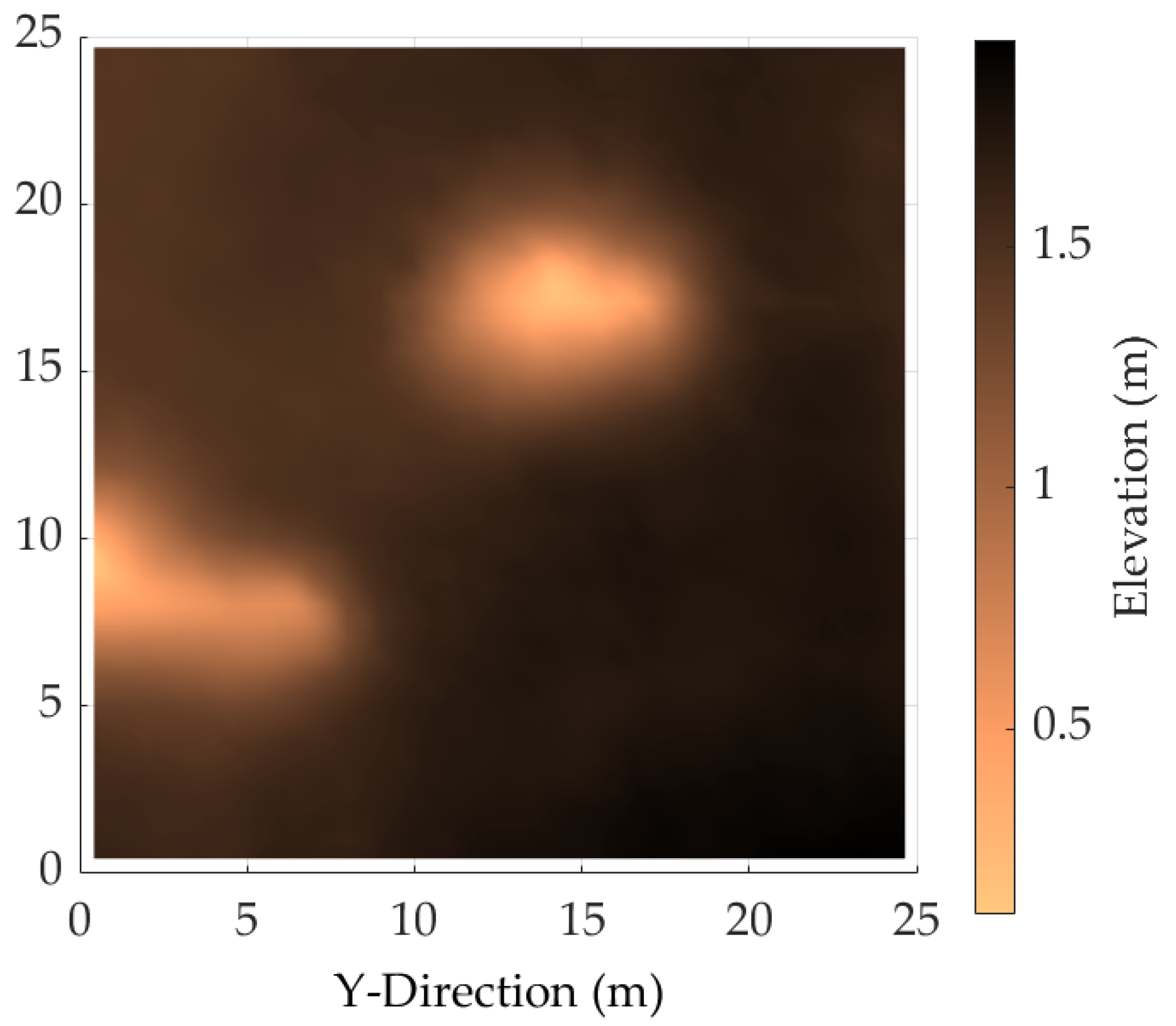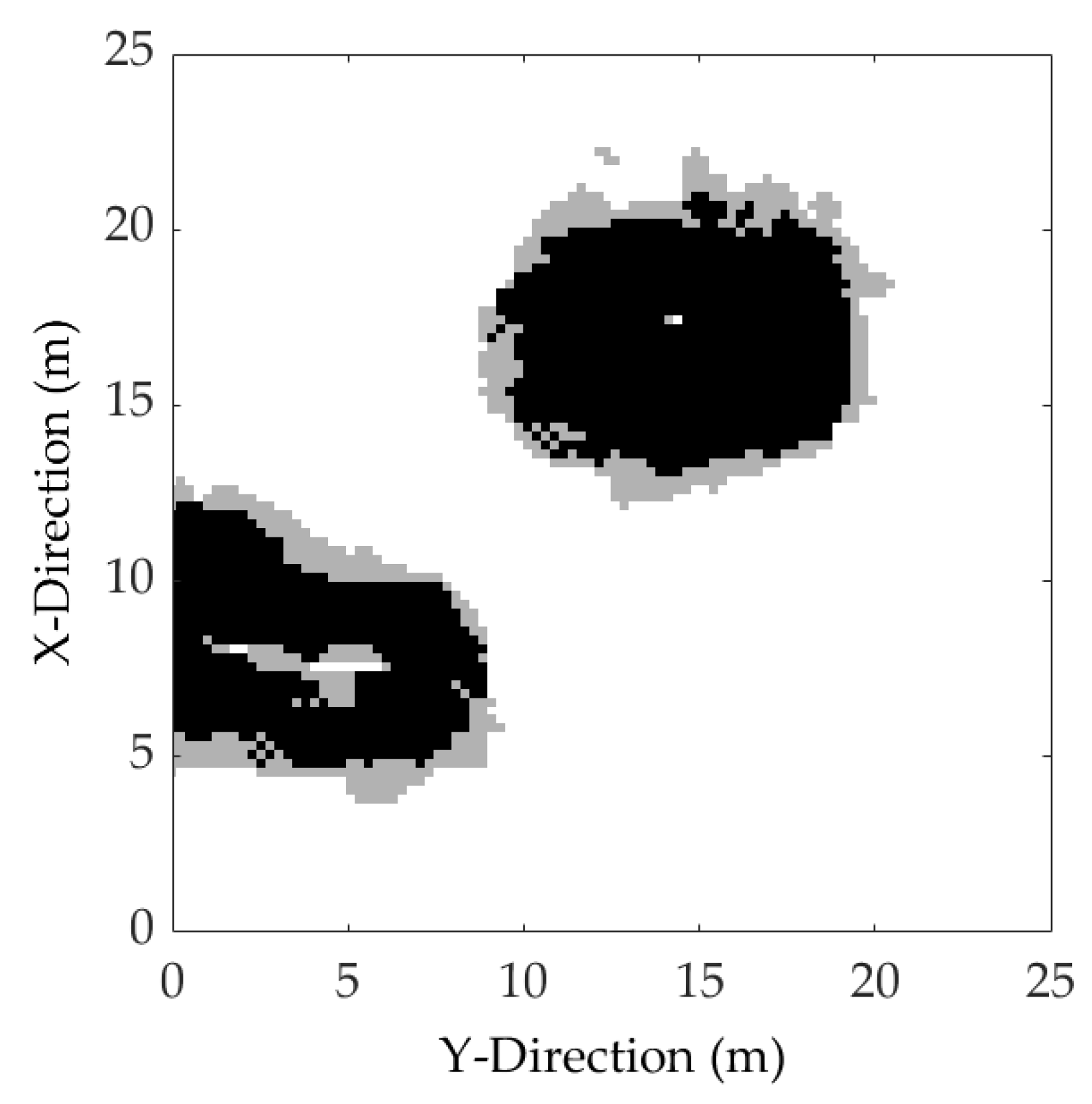Improving Rover Path Planning in Challenging Terrains: A Comparative Study of RRT-Based Algorithms
Abstract
1. Introduction
- The introduction of 3D-RRT*, an extension of the RRT* algorithm that directly incorporates terrain slope into its cost function.
- A comprehensive comparison of RRT-based planners using terrain-aware metrics, demonstrating the effectiveness of the 3D-RRT* algorithm through simulation experiments in a 3D Martian environment.
2. Related Work
2.1. Challenges of Path Planning for Planetary-Exploration Rovers
2.2. RRT-Based Path-Planning Algorithms
3. RRT-Based Path-Planning Algorithms
3.1. RRT
3.2. RRT*
3.3. Traversability-Based RRT*
3.4. 3D-RRT*
4. Experimental Set-Up
4.1. Introduction
4.2. Mathematical Model of a 6-Wheel Rocker Bogie Micro Rover
4.3. Guidance, Navigation, and Control
4.4. Environment Model
5. Results
5.1. Varying Maximum Nodes
5.2. Characteristics of the RRT-Based Path-Planning Algorithms
5.3. Path Quality
- Run Time (): This is the time taken by the path-planning algorithm to generate nodes and select a path.
- Path Length (): To evaluate path length, the Euclidean distance between each sequential node on the path is summed.
- Path Smoothness (): The path smoothness is defined as the total required turning angle accumulated over the path.
- Path Flatness (): The flatness of the path is evaluated by taking the slope angle associated with each node from the traversability analysis and summing over the full path.
5.4. Varying Cost Weights
6. Discussion
7. Conclusions
- Both terrain-aware planners (3D-RRT* and Traversability-Based RRT*) generated smoother, shorter, and flatter paths than classical RRT and RRT*.
- 3D-RRT* achieved comparable path quality to Traversability-Based RRT* while halving computational time.
- The 3D-RRT* algorithm’s simplicity and lack of platform-specific modelling make it well-suited to heterogeneous robot teams and dynamic mission environments.
Author Contributions
Funding
Institutional Review Board Statement
Informed Consent Statement
Data Availability Statement
Conflicts of Interest
References
- Ocampo, A.; Friedman, L.; Logsdon, J. Why space science and exploration benefit everyone. Space Policy 1998, 14, 137–143. [Google Scholar] [CrossRef]
- Sutton, J.P. Clinical benefits of bioastronautics. In Handbook of Bioastronautics; Springer International Publishing: Cham, Switzerland, 2021; pp. 7–19. [Google Scholar]
- Vernikos, J. Human exploration of space: Why, where, what for? Hippokratia 2008, 12 (Suppl. S1), 6. [Google Scholar]
- White, R.J.; Averner, M. Humans in space. Nature 2001, 409, 1115–1158. [Google Scholar] [CrossRef]
- Muirhead, B.K. Mars rovers, past and future. In Proceedings of the 2004 IEEE Aerospace Conference Proceedings (IEEE Cat. No. 04TH8720), Big Sky, MT, USA, 6–13 March 2004; IEEE: Piscataway, NJ, USA, 2004; Volume 1. [Google Scholar]
- Moeller, R.C.; Jandura, L.; Rosette, K.; Robinson, M.; Samuels, J.; Silverman, M.; Brown, K.; Duffy, E.; Yazzie, A.; Jens, E.; et al. The Sampling and Caching Subsystem (SCS) for the scientific exploration of Jezero crater by the Mars 2020 Perseverance rover. Space Sci. Rev. 2021, 217, 5. [Google Scholar] [CrossRef]
- Farley, K.A.; Williford, K.H.; Stack, K.M.; Bhartia, R.; Chen, A.; de la Torre, M.; Hand, K.; Goreva, Y.; Herd, C.D.; Hueso, R.; et al. Mars 2020 mission overview. Space Sci. Rev. 2020, 216, 142. [Google Scholar] [CrossRef]
- Koktas, E.; Başar, E. Communications for the planet mars: Past, present, and future. IEEE Aerosp. Electron. Syst. Mag. 2024, 39, 216–258. [Google Scholar] [CrossRef]
- Miao, Q.; Wei, G. A Comprehensive Review of Path-Planning Algorithms for Planetary Rover Exploration. Remote Sens. 2025, 17, 1924. [Google Scholar] [CrossRef]
- Swinton, S.; McGookin, E. Fault Diagnosis for a Team of Planetary Rovers. In Proceedings of the 2022 UKACC 13th International Conference on Control (CONTROL), Plymouth, UK, 20 April 2022; IEEE: Piscataway, NJ, USA, 2022; pp. 94–99. [Google Scholar]
- Dearden, R.; Willeke, T.; Simmons, R.; Verma, V.; Hutter, F.; Thrun, S. Real-time fault detection and situational awareness for rovers: Report on the mars technology program task. In Proceedings of the 2004 IEEE Aerospace Conference Proceedings (IEEE Cat. No. 04TH8720), Big Sky, MT, USA, 6–13 March 2004; IEEE: Piscataway, NJ, USA, 2004; Volume 2, pp. 826–840. [Google Scholar]
- Ricano, J.R.; Yuasa, S.; Hino, R.; Koshi, T.; Oyama, T.; Nagaoka, K. Resilient mobility of a four-wheeled planetary rover with active suspension. Acta Astronaut. 2025, 229, 418–429. [Google Scholar] [CrossRef]
- Swinton, S.; Ewers, J.H.; McGookin, E.; Anderson, D.; Thomson, D. Autonomous mission planning for planetary surface exploration using a team of micro rovers. Front. Robot. AI 2025, 12, 1565173. [Google Scholar] [CrossRef]
- Muñoz, P.; Bellutta, P.; R-Moreno, M.D. Proposing new path-planning metrics for operating rovers on Mars. Sci. Rep. 2023, 13, 22256. [Google Scholar] [CrossRef]
- Takemura, R.; Ishigami, G. Traversability-Based RRT* for planetary rover path planning in rough terrain with LIDAR point cloud data. J. Robot. Mechatronics 2017, 29, 838–846. [Google Scholar] [CrossRef]
- Ishigami, G.; Nagatani, K.; Yoshida, K. Path following control with slip compensation on loose soil for exploration rover. In Proceedings of the 2006 IEEE/RSJ International Conference on Intelligent Robots and Systems, Beijing, China, 9–15 October 2006; IEEE: Piscataway, NJ, USA, 2006; pp. 5552–5557. [Google Scholar]
- Ishigami, G.; Nagatani, K.; Yoshida, K. Path planning for planetary exploration rovers and its evaluation based on wheel slip dynamics. In Proceedings of the 2007 IEEE International Conference on Robotics and Automation, Roma, Italy, 10 April 2007; IEEE: Piscataway, NJ, USA, 2007; pp. 2361–2366. [Google Scholar]
- Sock, J.; Kim, J.; Min, J.; Kwak, K. Probabilistic traversability map generation using 3D-LIDAR and camera. In Proceedings of the 2016 IEEE International Conference on Robotics and Automation (ICRA), Stockholm, Sweden, 16 May 2016; IEEE: Piscataway, NJ, USA, 2016; pp. 5631–5637. [Google Scholar]
- Dergachev, S.; Muravyev, K.; Yakovlev, K. 2.5 d mapping, pathfinding and path following for navigation of a differential drive robot in uneven terrain. IFAC-PapersOnLine 2022, 55, 80–85. [Google Scholar] [CrossRef]
- Vayugundla, M.; Kuhne, M.; Wedler, A.; Triebel, R. Datasets and Benchmarking of a path planning pipeline for planetary rovers. In Proceedings of the 2022 IEEE/RSJ International Conference on Intelligent Robots and Systems (IROS) Workshop: Evaluating Motion Planning Performance, Kyoto, Japan, 23 October 2022. [Google Scholar]
- Ono, M.; Fuchs, T.J.; Steffy, A.; Maimone, M.; Yen, J. Risk-aware planetary rover operation: Autonomous terrain classification and path planning. In Proceedings of the 2015 IEEE Aerospace Conference, Big Sky, MT, USA, 7 March 2015; IEEE: Piscataway, NJ, USA, 2015; pp. 1–10. [Google Scholar]
- Flessa, T.; McGookin, E.W.; Thomson, D.G. Taxonomy, systems review and performance metrics of planetary exploration rovers. In Proceedings of the 2014 13th International Conference on Control Automation Robotics & Vision (ICARCV), Singapore, 10–12 December 2014; IEEE: Piscataway, NJ, USA, 2014; pp. 1554–1559. [Google Scholar]
- Harrington, B.D.; Voorhees, C. The challenges of designing the rocker-bogie suspension for the mars exploration rover. In Proceedings of the 37th Aerospace Mechanisms Symposium, Galveston, TX, USA, 19–21 May 2004. [Google Scholar]
- Rankin, A.; Maimone, M.; Biesiadecki, J.; Patel, N.; Levine, D.; Toupet, O. Driving curiosity: Mars rover mobility trends during the first seven years. In Proceedings of the 2020 IEEE Aerospace Conference, Big Sky, MT, USA, 7–14 March 2020; IEEE: Piscataway, NJ, USA, 2020; pp. 1–19. [Google Scholar]
- Yen, J. Slip Validation and Prediction for Mars Exploration Rovers. Sens. Transducers 2008, 90, 233–242. [Google Scholar]
- Bajracharya, M.; Maimone, M.W.; Helmick, D. Autonomy for mars rovers: Past, present, and future. Computer 2008, 41, 44–50. [Google Scholar] [CrossRef]
- Carsten, J.; Rankin, A.; Ferguson, D.; Stentz, A. Global path planning on board the mars exploration rovers. In Proceedings of the 2007 IEEE Aerospace Conference, Big Sky, MT, USA, 3–10 March 2007; IEEE: Piscataway, NJ, USA, 2007; pp. 1–11. [Google Scholar]
- Ferguson, D.; Stentz, A. Using interpolation to improve path planning: The Field D* algorithm. J. Field Robot. 2006, 23, 79–101. [Google Scholar] [CrossRef]
- Carsten, J.; Rankin, A.; Ferguson, D.; Stentz, A. Global planning on the mars exploration rovers: Software integration and surface testing. J. Field Robot. 2009, 26, 337–357. [Google Scholar] [CrossRef]
- Verma, V.; Maimone, M.W.; Gaines, D.M.; Francis, R.; Estlin, T.A.; Kuhn, S.R.; Rabideau, G.R.; Chien, S.A.; McHenry, M.M.; Graser, E.J.; et al. Autonomous robotics is driving Perseverance rover’s progress on Mars. Sci. Robot. 2023, 8, eadi3099. [Google Scholar] [CrossRef] [PubMed]
- Verma, V.; Hartman, F.; Rankin, A.; Maimone, M.; Del Sesto, T.; Toupet, O.; Graser, E.; Myint, S.; Davis, K.; Klein, D.; et al. First 210 solar days of Mars 2020 Perseverance robotic operations-mobility, robotic arm, sampling, and helicopter. In Proceedings of the 2022 IEEE Aerospace Conference (AERO), Big Sky, MT, USA, 5–12 March 2022; IEEE: Piscataway, NJ, USA, 2022; pp. 1–20. [Google Scholar]
- Sakayori, G.; Ishigami, G. Energy-aware trajectory planning for planetary rovers. Adv. Robot. 2021, 35, 1302–1316. [Google Scholar] [CrossRef]
- Lamarre, O.; Limoyo, O.; Marić, F.; Kelly, J. The Canadian planetary emulation terrain energy-aware rover navigation dataset. Int. J. Robot. Res. 2020, 39, 641–650. [Google Scholar] [CrossRef]
- Plonski, P.A.; Tokekar, P.; Isler, V. Energy-efficient path planning for solar-powered mobile robots. J. Field Robot. 2013, 30, 583–601. [Google Scholar] [CrossRef]
- Fallah, S.; Yue, B.; Vahid-Araghi, O.; Khajepour, A. Energy management of planetary rovers using a fast feature-based path planning and hardware-in-the-loop experiments. IEEE Trans. Veh. Technol. 2013, 62, 2389–2401. [Google Scholar] [CrossRef]
- LaValle, S. Rapidly-Exploring Random Trees: A New Tool for Path Planning; Research Report. TR 98-11; Iowa State University: Ames, IA, USA, 1998. [Google Scholar]
- Karaman, S.; Frazzoli, E. Sampling-based algorithms for optimal motion planning. Int. J. Robot. Res. 2011, 30, 846–894. [Google Scholar] [CrossRef]
- Urmson, C.; Simmons, R. Approaches for heuristically biasing RRT growth. In Proceedings of the 2003 IEEE/RSJ International Conference on Intelligent Robots and Systems (IROS 2003) (Cat. No. 03CH37453), Las Vegas, NV, USA, 27 October–1 November 2003; IEEE: Piscataway, NJ, USA, 2003; Volume 2, pp. 1178–1183. [Google Scholar]
- Ettlin, A.; Bleuler, H. Rough-terrain robot motion planning based on obstacleness. In Proceedings of the 2006 9th International Conference on Control, Automation, Robotics and Vision, Singapore, 5–8 December 2006; IEEE: Piscataway, NJ, USA, 2006; pp. 1–6. [Google Scholar]
- Wang, Y.; Yuan, Q.; Guo, Y.; Han, W. Path planning for lunar rover based on Bi-RRT algorithm. In Proceedings of the 2021 40th Chinese Control Conference (CCC), Shanghai, China, 26 July 2021; IEEE: Piscataway, NJ, USA, 2021; pp. 4211–4216. [Google Scholar]
- Swinton, S.; McGookin, E. A Novel, RRT* Based Approach to the Coordination of Multiple Planetary Rovers. In Proceedings of the 2022 UKACC 13th International Conference on Control (CONTROL), Plymouth, UK, 20 April 2022; IEEE: Piscataway, NJ, USA, 2022; pp. 88–93. [Google Scholar]
- Hidalgo-Paniagua, A.; Bandera, J.P.; Ruiz-de-Quintanilla, M.; Bandera, A. Quad-RRT: A real-time GPU-based global path planner in large-scale real environments. Expert Syst. Appl. 2018, 99, 141–154. [Google Scholar] [CrossRef]
- Wang, J.; Chi, W.; Li, C.; Wang, C.; Meng, M.Q. Neural RRT*: Learning-based optimal path planning. IEEE Trans. Autom. Sci. Eng. 2020, 17, 1748–1758. [Google Scholar] [CrossRef]
- Liao, B.; Wan, F.; Hua, Y.; Ma, R.; Zhu, S.; Qing, X. F-RRT*: An improved path planning algorithm with improved initial solution and convergence rate. Expert Syst. Appl. 2021, 184, 115457. [Google Scholar] [CrossRef]
- Yu, J.; Chen, C.; Arab, A.; Yi, J.; Pei, X.; Guo, X. RDT-RRT: Real-time double-tree rapidly-exploring random tree path planning for autonomous vehicles. Expert Syst. Appl. 2024, 240, 122510. [Google Scholar] [CrossRef]
- Lanfeng, Z.; Lina, Y.; Hua, F. Lunar Rover Path Planning Based on Comprehensive Genetic Algorithm Based on Slip Prediction. J. Phys. Conf. Ser. 2019, 1267, 012097. [Google Scholar] [CrossRef]
- Zhang, J.; Xia, Y.; Shen, G. A novel learning-based global path planning algorithm for planetary rovers. Neurocomputing 2019, 361, 69–76. [Google Scholar] [CrossRef]
- Yu, X.; Wang, P.; Zhang, Z. Learning-based end-to-end path planning for lunar rovers with safety constraints. Sensors 2021, 21, 796. [Google Scholar] [CrossRef] [PubMed]
- McEwen, A.S.; Eliason, E.M.; Bergstrom, J.W.; Bridges, N.T.; Hansen, C.J.; Delamere, W.A.; Grant, J.A.; Gulick, V.C.; Herkenhoff, K.E.; Keszthelyi, L.; et al. Mars reconnaissance orbiter’s high resolution imaging science experiment (HiRISE). J. Geophys. Res. Planets 2007, 112, E05S02. [Google Scholar] [CrossRef]
- Fossen, T.I. Handbook of Marine Craft Hydrodynamics and Motion Control; John Wiley & Sons: Hoboken, NJ, USA, 2011. [Google Scholar]
- Swinton, S.; McGookin, E.; Thomson, D. Design of a Health Monitoring System for a Planetary Exploration Rover. In Proceedings of the 2024 International Conference on Space Robotics (iSpaRo), Luxembourg, 24 June 2024; IEEE: Piscataway, NJ, USA, 2024; pp. 218–223. [Google Scholar]
- Breivik, M. Nonlinear Maneuvering Control of Underactuated Ships. Master’s Thesis, Norwegian University of Science and Technology, Trondheim, Norway, 2003. [Google Scholar]
- HiRISE. University of Arizona [Internet]. Candidate Landing Site for 2020 Mission in Jezero Crater. Available online: https://www.uahirise.org/dtm/dtm.php?ID=ESP_045994_1985 (accessed on 11 August 2022).
- Bergstrom, J.W.; Delamere, W.A.; McEwen, A. MRO High Resolution Imaging Science Experiment (HiRISE): Instrument Test, Calibration and Operating Constraints. In Proceedings of the 55th International Astronautical Congress of the International Astronautical Federation, the International Academy of Astronautics, and the International Institute of Space Law 2004, Vancouver, BC, Canada, 4–8 October 2004; p. Q-3. [Google Scholar]
- Türkkol, B.Z.; Altuntaş, N.; Çekirdek Yavuz, S. A Smooth Global Path Planning Method for Unmanned Surface Vehicles Using a Novel Combination of Rapidly Exploring Random Tree and Bézier Curves. Sensors 2024, 24, 8145. [Google Scholar] [CrossRef] [PubMed]













| Planner Type | ||||||||
|---|---|---|---|---|---|---|---|---|
| RRT | 0.378 | 0.006 | 40.975 | 2.994 | 29.055 | 4.291 | 2.000 | 0.141 |
| RRT* | 1.161 | 0.007 | 40.156 | 2.555 | 27.818 | 4.173 | 1.948 | 0.121 |
| Traversability-Based RRT* | 14.078 | 0.449 | 35.114 | 1.614 | 9.903 | 1.7588 | 1.142 | 0.083 |
| 3D-RRT* | 6.437 | 0.144 | 35.457 | 1.859 | 9.707 | 1.864 | 1.133 | 0.080 |
| ID | Path Planner | |||||
|---|---|---|---|---|---|---|
| A | Traversability-Based RRT* | 0.7 | 0.1 | 0.1 | 0.1 | N/A |
| B | Traversability-Based RRT* | 0.1 | 0.1 | 0.1 | 0.7 | N/A |
| C | Traversability-Based RRT* | 0.1 | 0.4 | 0.4 | 0.1 | N/A |
| D | 3D-RRT* | 0.8 | N/A | N/A | 0.1 | 0.1 |
| E | 3D-RRT* | 0.1 | N/A | N/A | 0.8 | 0.1 |
| F | 3D-RRT* | 0.1 | N/A | N/A | 0.1 | 0.8 |
Disclaimer/Publisher’s Note: The statements, opinions and data contained in all publications are solely those of the individual author(s) and contributor(s) and not of MDPI and/or the editor(s). MDPI and/or the editor(s) disclaim responsibility for any injury to people or property resulting from any ideas, methods, instructions or products referred to in the content. |
© 2025 by the authors. Licensee MDPI, Basel, Switzerland. This article is an open access article distributed under the terms and conditions of the Creative Commons Attribution (CC BY) license (https://creativecommons.org/licenses/by/4.0/).
Share and Cite
Swinton, S.; McGookin, E.; Thomson, D. Improving Rover Path Planning in Challenging Terrains: A Comparative Study of RRT-Based Algorithms. Robotics 2025, 14, 135. https://doi.org/10.3390/robotics14100135
Swinton S, McGookin E, Thomson D. Improving Rover Path Planning in Challenging Terrains: A Comparative Study of RRT-Based Algorithms. Robotics. 2025; 14(10):135. https://doi.org/10.3390/robotics14100135
Chicago/Turabian StyleSwinton, Sarah, Euan McGookin, and Douglas Thomson. 2025. "Improving Rover Path Planning in Challenging Terrains: A Comparative Study of RRT-Based Algorithms" Robotics 14, no. 10: 135. https://doi.org/10.3390/robotics14100135
APA StyleSwinton, S., McGookin, E., & Thomson, D. (2025). Improving Rover Path Planning in Challenging Terrains: A Comparative Study of RRT-Based Algorithms. Robotics, 14(10), 135. https://doi.org/10.3390/robotics14100135






